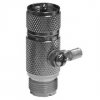SWR on whip
In the late '70s and early '80s a friend and I partnered a business selling and installing CBs and antennas. We sold and installed probably fifty 102" whips on springs. Common in the NE, most installations were on back bumpers. Long coax trips.
I'm betting we had fewer than 10% match better than 2:1 and it got worse with 40 channel. I used the things on my 4WDs and I don't recall worrying about it. I ran legal power radios with SSB and performace in those Allegheny Mountains was spectacular.
With your antenna in the vehicle center, your radiation pattern should be much less directional than mine were from the extreme rear. I would take seriously all the advice about grounding and connecting all the parts of the bed and cab, and I'd run the power from the battery and the ground to something substantial under the hood. (In the old days we usually grounded to one of the bolts holding down the voltage regualtor or fuse box.)
Do everyting you can to keep water out of the connectors and coax. That may mean "monkey poo" or some such "putty" sealer around the connectors. If you've already gotten the coax system full of water, swap it out and protect the new stuff.
If you're within the legal power envelope you may be over-thinking it. Attention to the simple, basic details seems to yield the biggest gains.
Just MHO.
In the late '70s and early '80s a friend and I partnered a business selling and installing CBs and antennas. We sold and installed probably fifty 102" whips on springs. Common in the NE, most installations were on back bumpers. Long coax trips.
I'm betting we had fewer than 10% match better than 2:1 and it got worse with 40 channel. I used the things on my 4WDs and I don't recall worrying about it. I ran legal power radios with SSB and performace in those Allegheny Mountains was spectacular.
With your antenna in the vehicle center, your radiation pattern should be much less directional than mine were from the extreme rear. I would take seriously all the advice about grounding and connecting all the parts of the bed and cab, and I'd run the power from the battery and the ground to something substantial under the hood. (In the old days we usually grounded to one of the bolts holding down the voltage regualtor or fuse box.)
Do everyting you can to keep water out of the connectors and coax. That may mean "monkey poo" or some such "putty" sealer around the connectors. If you've already gotten the coax system full of water, swap it out and protect the new stuff.
If you're within the legal power envelope you may be over-thinking it. Attention to the simple, basic details seems to yield the biggest gains.
Just MHO.



